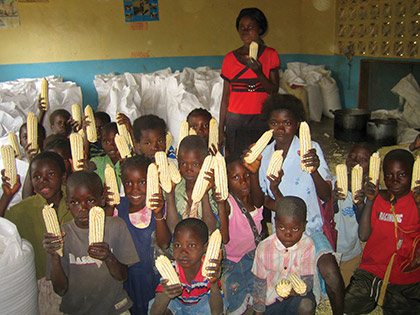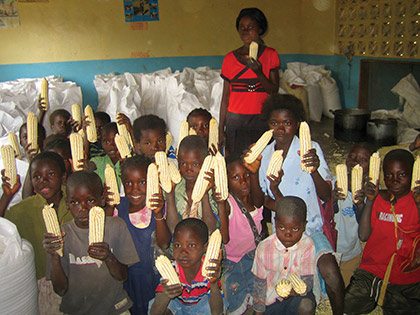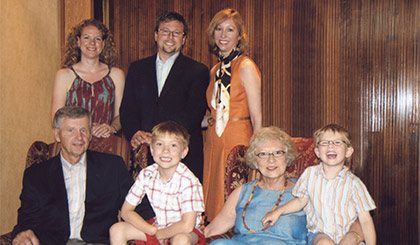Canadian Seed Sector Makes a Difference in Africa
The seed industry is supporting a project to provide education and agricultural training to Zambian children.
Imagine living on less than a dollar a day and needing to find tuition money for your child to start Grade One. Imagine a child skinning his knee, with no mother to clean the wound and no bandage to cover it. Imagine having to learn how to earn a living on your family farm, when you are 14 and your parents are gone.
In a remote corner of northwestern Zambia, there are two schools providing orphans and vulnerable children with an education that they would otherwise miss. The schools are part of the Manyinga Community Resource Centre, a project started in 2008 that teaches more than 400 students a year.
In Zambia, 85 per cent of the population are farmers, and children generally learn how to farm from their parents. The schools’ agriculture program is aimed at teaching orphans and vulnerable children essential agricultural skills. In this region, where diseases like AIDS, malaria and tuberculosis are commonplace, these children represent a significant portion of a population who could easily fall into poverty if they lack an education or the ability to farm for a living.
The Manyinga Community Resource Centre offers students essential lessons in agriculture as well as traditional curriculum.
Located in the Zambian communities of Chinema and Samafunda, the Manyinga schools welcome orphans and vulnerable children at no cost from Grades 1 to 7. The schools have three primary goals:
• To train children to become viable commercial farmers and successful gardeners
• To provide a free education where students can qualify for state exams at the end of Grade 7
• To generate income to support a portion of the school operating costs
The agricultural program teaches students about orchards, gardens, field crops and livestock. In 2011, about 32 acres of maize, sweet potatoes and beans were planted, with yields increasing 200 to 300 per cent over the previous year through the use of fertilizer and better seed. In addition, the schools plant and harvest banana, guava, orange and tangerine, and there’s also a small herd of goats. Part of each year’s crop is used to help feed the students, while the rest is sold and the proceeds reinvested in the schools.
Recently, a special campaign spearheaded by Dorothy Murrell and Brenda Trask, communications manager with SeCan aimed to fill one of the school’s needs. Joan’s House is a project to open a teachers’ house at each of the Manyinga schools. In rural areas, teachers sometimes need to travel miles to get to their students. In many Zambian schools, accommodation is provided for the teachers on-site, so they don’t have to travel each day.
The project’s namesake is Joan Anderson, a lifelong advocate for education who passed away in 2013. Joan’s influence also reached into the ag world, where her husband Bob Anderson is a long-time Manitoba seed grower and her children, Robynne and Chris, continue to be huge contributors to the agriculture industry. Robynne is also one of the volunteers who helped found the school. The project aims to raise $4,000 for each school, and local labour will be used to build the houses, meaning the money will be injected into the local economy.
The Anderson Family at the Canadian Seed Trade Association Annual Meeting.
The students are taught a regular state curriculum, with the agricultural program being a supplementary part of their education at Manyinga. They are taught once a week by an agriculturalist. In the lower grades, students focus on gardening, and move into field crops in the higher grades. Older students are also taught marketing and entrepreneurial skills, which are incorporated into their math class.
The school isn’t just about agriculture, as evidenced by the fact that Manyinga students regularly pass the state-wide exams for entrance into Grade 8 at higher rates than other schools in the area. Some of the students from the first class of the schools have now graduated. Those students are working towards futures in teaching, medicine and computers. They attended the school when there was no buildings, water well, or even latrines.
“The program has had some remarkable successes as a result of the students’ determination. Some travel more than an hour each way to attend class,” says Robynne Anderson. One student, who had lost the use of his legs to polio, dragged himself on a sledge for more than an hour to attend class each day until a specialized cart with hand pedals could be purchased for him. With the free tuition offered at the school, he passed his Grade 8 entrance exams and is now sponsored to continue his education in the state system. He hopes to work with computers after graduating.
“The Canadian working committee, which includes a team from Suckerpunch Creative, Dr. Allan Ronald, Myrna Ronald, and Cam Dahl, president of Cereals Canada, continues to do important work, particularly with the agricultural program,” says Robynne Anderon. As the school has grown, however, more and more of the governance is being done by the community. With the headmaster/headmistress in place as well as the formation of a local parent-teacher board for the Zambian schools, the Canadian committee is shifting towards a support role.
All of this is made possible by family friend, Marian Ronald, a nurse who was raised on a farm in Portage la Prairie, Man., who has made her home in this remote corner of Zambia for 40 years.
The schools have seen much growth since they began, but the biggest challenge facing the Manyinga program is paying the salaries of its teachers, who on average receive $1,500 per year. The dedication of Manyinga’s teachers is a huge part of why the project has been a success. In the past, when sources of funding have run dry, they have continued to work without pay until funding could resume again.
Paying teachers’ salaries needs to be done through the program, until the Zambian government assumes the responsibility. Though the Manyinga program aims to become self-sufficient, it needs help with its financial responsibilities until it can achieve this goal.
For less than a third of one Canadian teacher’s salary, it is possible to send more than 500 children to school, provide a living for their teachers, and improve the prospects for many Zambian orphans and vulnerable youth for a fruitful and viable life on the farm.
Connor Rosine
Joan’s LegacyMany thanks on behalf of the Manyinga Community Resource Centre to those in the seed sector who have supported Joan’s House and the Manyinga project in general. In addition to numerous anonymous contributors, Joan’s House donors include: Erin Armstrong, Manitoba Shawn Brook, Manitoba Art Enns, Manitoba Wayne Gale, Ontario Peter Hannam, Ontario Doug Knight and Brenda Frank, Saskatchewan Bill Leask, Ontario Kim McConnell, Alberta Patti McNabb, Manitoba Monsanto Canada Dorothy Murrell, Saskatchewan David and Anne Sippell, Minnesota Brenda Trask, Ontario John Zuelzer & Son, British Columbia To contribute to Joan’s House, visit manyinga.org. |















